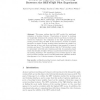Free Online Productivity Tools
i2Speak
i2Symbol
i2OCR
iTex2Img
iWeb2Print
iWeb2Shot
i2Type
iPdf2Split
iPdf2Merge
i2Bopomofo
i2Arabic
i2Style
i2Image
i2PDF
iLatex2Rtf
Sci2ools
MLMI
2007
Springer
2007
Springer
Towards an Objective Test for Meeting Browsers: The BET4TQB Pilot Experiment
This paper outlines first the BET method for task-based evaluation of meeting browsers. ‘Observations of interest’ in meetings are empirically determined by neutral observers and then processed and ordered by evaluators. The evaluation of the TQB annotation-driven meeting browser using the BET is then described. A series of subjects attempted to answer as many meeting-related questions as possible in a fixed amount of time, and their performance was measured in terms of precision and speed. The results indicate that the TQB interface is easy to understand with little prior learning and that its annotation-based search functionality is highly relevant, in particular keyword search over the meeting transcript. Two knowledge-poorer browsers appear to offer lower precision but higher speed. The BET task-based evaluation method thus appears to be a coherent measure of browser quality. Key words: multimedia meeting browsers, task-based evaluation, humancomputer interaction, human fact...
BET Task-based Evaluation | Machine Learning | Meeting Browsers | MLMI 2007 | Task-based Evaluation |
| Added | 08 Jun 2010 |
| Updated | 08 Jun 2010 |
| Type | Conference |
| Year | 2007 |
| Where | MLMI |
| Authors | Andrei Popescu-Belis, Philippe Baudrion, Mike Flynn, Pierre Wellner |
Comments (0)

